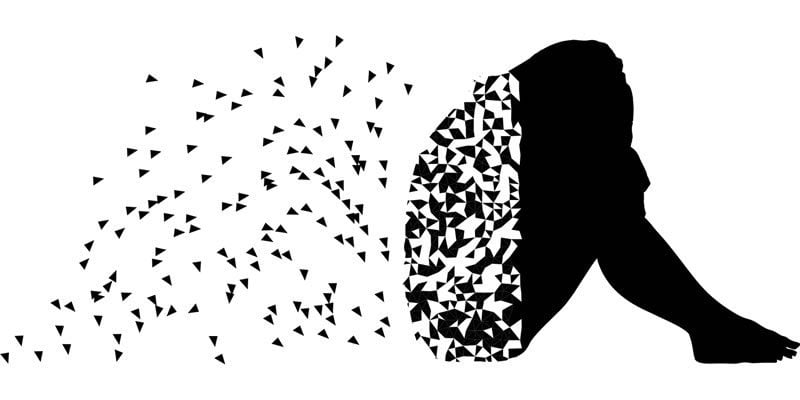Summary: Lower levels of the circular RNA in the frontal cortex appears to be correlated with earlier onset of schizophrenia symptoms.
Source: University of New Mexico
In Biology 101 you were taught that inside each cell, tiny strands of a molecule called RNA “transcribe” the genetic code in your DNA, the first step in the process of building the proteins that make up your body.
But in recent years the picture has grown more complicated. It turns out there are also circular, non-coding forms of RNA that regulate various aspects of gene expression, allowing many of our 20,000 genes to make more than one form of each protein.
Now, University of New Mexico scientists have shown that reduced levels of a type of circular RNA found in the brain with the ungainly name of circHomer1a are associated with schizophrenia and bipolar disorder. Lower levels of the molecule in the human frontal cortex were also seen to be correlated with earlier onset of schizophrenia symptoms.
In a paper newly published in the journal Molecular Psychiatry, the researchers report that lowering levels of circHomer1a in the mouse brain’s frontal cortex results in impaired gene expression related to the function of the synapses – junctions at the ends of neurons that enable them to “talk” to their neighbors.
The team also showed that in mice, reduction of circHomer1a in the frontal cortex diminished their cognitive flexibility – the ability to respond to changing circumstances. This impairment is commonly seen in people with bipolar disorder.

“These mice can learn and discriminate, but when it comes time for them to adjust their behavior, they are very deficient,” said lead author Nikolaos Mellios, MD, PhD, assistant professor in the Department of Neurosciences. “It takes them way more trials to reverse their behavior.”
Recent studies have shown that the brains of mammals are rich in circular RNAs, and it appears that they powerfully shape the way genes are transcribed to RNA and translated into proteins, Mellios said.
“They don’t produce any proteins, but there’s emerging research showing that they have important regulatory roles,” he said. “They are like conductors in an orchestra. You need these circular RNAs to fine-tune the expression of multiple genes.”
Because circular RNAs are more stable in the body than their linear cousins, they could potentially serve as biomarkers to help clinicians diagnose disease, Mellios said. And, there’s a possibility that treatments could be developed to enhance their effects in the brain.
“Our lab is working on ways to find the proper approach to manipulate these circular RNAs specifically in patients,” he said. “We’re also trying to find which drugs will specifically change these circular RNAs as a treatment.”
Mellios credited Department of Neurosciences colleagues Jonathan Brigman and Nora Perrone-Bizzozero and graduate students Amber Zimmerman, Alexander Hafez and Stephen Amoah for their important contributions to the study.
The paper is the first in a series that will explore the role circHomer1a plays in brain health, he said.
Source:
University of New Mexico
Media Contacts:
Mark Rudi – University of New Mexico
Image Source:
The image is in the public domain.
Original Research: Open access
“A psychiatric disease-related circular RNA controls synaptic gene expression and cognition”. Amber J. Zimmerman, Alexander K. Hafez, Stephen K. Amoah, Brian A. Rodriguez, Michela Dell’Orco, Evelyn Lozano, Brigham J. Hartley, Begüm Alural, Jasmin Lalonde, Praveen Chander, Maree J. Webster, Roy H. Perlis, Kristen J. Brennand, Stephen J. Haggarty, Jason Weick, Nora Perrone-Bizzozero, Jonathan L. Brigman & Nikolaos Mellios.
Molecular Psychiatry doi:10.1038/s41380-020-0653-4.
Abstract
A psychiatric disease-related circular RNA controls synaptic gene expression and cognition
Although circular RNAs (circRNAs) are enriched in the mammalian brain, very little is known about their potential involvement in brain function and psychiatric disease. Here, we show that circHomer1a, a neuronal-enriched circRNA abundantly expressed in the frontal cortex, derived from Homer protein homolog 1 (HOMER1), is significantly reduced in both the prefrontal cortex (PFC) and induced pluripotent stem cell-derived neuronal cultures from patients with schizophrenia (SCZ) and bipolar disorder (BD). Moreover, alterations in circHomer1a were positively associated with the age of onset of SCZ in both the dorsolateral prefrontal cortex (DLPFC) and orbitofrontal cortex (OFC). No correlations between the age of onset of SCZ and linear HOMER1 mRNA were observed, whose expression was mostly unaltered in BD and SCZ postmortem brain. Using in vivo circRNA-specific knockdown of circHomer1a in mouse PFC, we show that it modulates the expression of numerous alternative mRNA transcripts from genes involved in synaptic plasticity and psychiatric disease. Intriguingly, in vivo circHomer1a knockdown in mouse OFC resulted in specific deficits in OFC-mediated cognitive flexibility. Lastly, we demonstrate that the neuronal RNA-binding protein HuD binds to circHomer1a and can influence its synaptic expression in the frontal cortex. Collectively, our data uncover a novel psychiatric disease-associated circRNA that regulates synaptic gene expression and cognitive flexibility.






